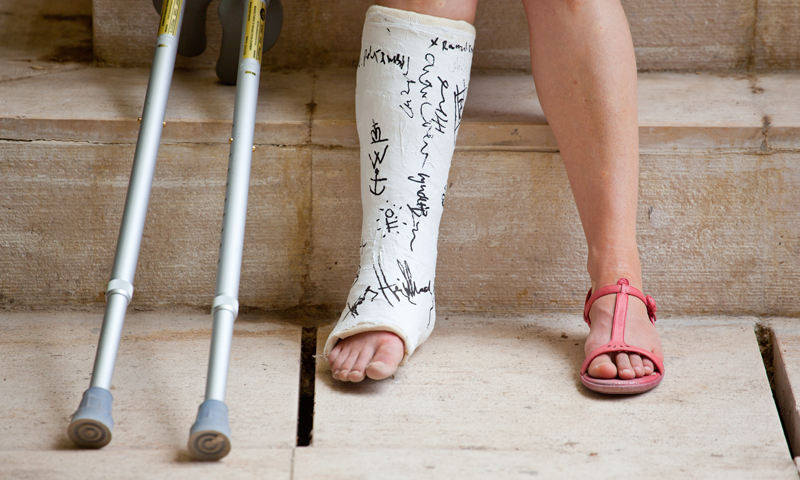
Does Yoga and Meditation Help You Live Longer?
October 17, 2019
Yoga: Overcoming Negative Thinking
October 31, 2019Returning to Yoga After an Injury

All yogis will experience some kind of injury in their lifetime. For regular practitioners, this can not only set back your physical practice but also negatively affect your mental health. For many of us, yoga is the outlet we need to keep a positive mind and spirit. Because of this, injury can leave us feeling lost, depressed and anxious as we wonder when we can return to the practice. Thankfully, as yoga is a gentle practice, you should be able to return fairly quickly. However, there are certain steps and precautions you must take to prevent further damage.
If you’re unsure whether you’re ready to return to yoga, contact your GP or health practitioner for some professional advice. If you feel ready to put your yoga pants back on, begin with a gentle approach and work back up if your body allows. In this article, we explore returning to yoga after an injury in more detail.
Practice Meditation
Seated meditation is a great way to get back into yoga after an injury. As the practice requires little movement, there’s no chance of causing further damage. This means that you can meditate at any time after an injury, even if you’re not ready to practice asanas yet. Daily meditation is a great way to reduce the stress and frustration that come with injury, particularly if your movement is restricted. Regular meditation can cultivate a positive attitude and help to speed up your recovery time. If you have trouble sitting, walking meditation may work better for you. Try a few different techniques and see which feels the most comfortable.
Start Slow
When you’re ready to return to you, restart with the basics. Before practicing a complex asana, try some pranayama breathing techniques and simple postures to test your limitations. Move slowly and listen to your body throughout the pose. If you feel any pain or discomfort, slowly release the posture and move onto something different. If you’ve been out for a while, it may take some time to return to your old yoga-self. Be kind to yourself and take time to re-form the connections between your mind, body, breath, and movement. Once you’ve performed a simple asana series, pay attention to your body and see how you feel. Your body will tell you if it needs to rest or it’s ready to move onto something new. If it feels comfortable, gradually add in more complex asanas, remember to take things slow and easy.
Use Restorative Yoga
Once you feel comfortable with basic postures, you may want to practice some restorative yoga. A restorative yoga class uses yoga blocks, bolsters, blankets, and other props to support the body while holding asanas for an extended duration. The practice induces deep relaxation while gently stretching the muscles, joints and connective tissues. As each posture is held for several breaths, you’ll have enough time to adjust your form to accommodate your injury. If something feels a little off, adjust your position to something more comfortable. Through the asanas, remain mindful and avoid letting excess tension build in your area of injury.

Level Down
When returning to yoga after an injury, you can’t jump straight back in where you left off. Instead, level down your practice for a while. Before attending a class, find out how challenging it is to make sure it’s suitable for your current ability. Once you’ve found a suitable class, stick with it for a couple of weeks before advancing to a more demanding session. Slow-paced, gentle classes are best suited to those recovering from an injury. Avoid fast-paced vinyasa classes until you’re 100% sure you’re back to your old self. Simple repetitive movements will be most helpful for improving mobility, strength, and range of motion throughout the body.
Use Modifications and Props
As your body heals, make use of modifications and props to minimize pressure to your area of injury. If you’re unsure how to modify a certain asana, get to class early and talk things through with the teacher. This way, they’ll be aware of your injury and help you to modify postures accordingly. Instead of feeling frustrated by your restrictions, take this time to embrace props and experience a new side of yoga. You never know, you might love it!
Avoid Pain
When translated from Sanskrit, Ahimsa means “to do no harm to yourself or others”. When returning to yoga after an injury, keep this phrase in the front of your mind. When practicing with an injury, avoid doing anything that hurts. When you’re injured, there’s no benefit to pushing through pain; instead, you’ll only risk more damage. If a yoga pose causes pain in your area of injury, take things slow, modify it or skip the posture entirely. If you need to opt-out of a pose, rest is Corpse or Child’s Pose or repeat a previous asana.
Inform Your Instructor
An experienced yoga teacher will know how to work around common injuries. When you return to class, get there early and speak with your instructor so they can figure out how best to support you. If your injury is more complex, consider booking a few private lessons so you can find the modifications that work best for you.
In Summary
When returning to yoga after an injury, keep the above tips in mind. Above all else, remember to be patient. The worst thing you can do is push yourself too far, too soon. Instead of rehabilitating the injury, this could set you back further and possibly keep you off the yoga mat for good. Being patient, taking things slow and maintaining a gentle practice will allow you to recover sooner and get back to your old self.

